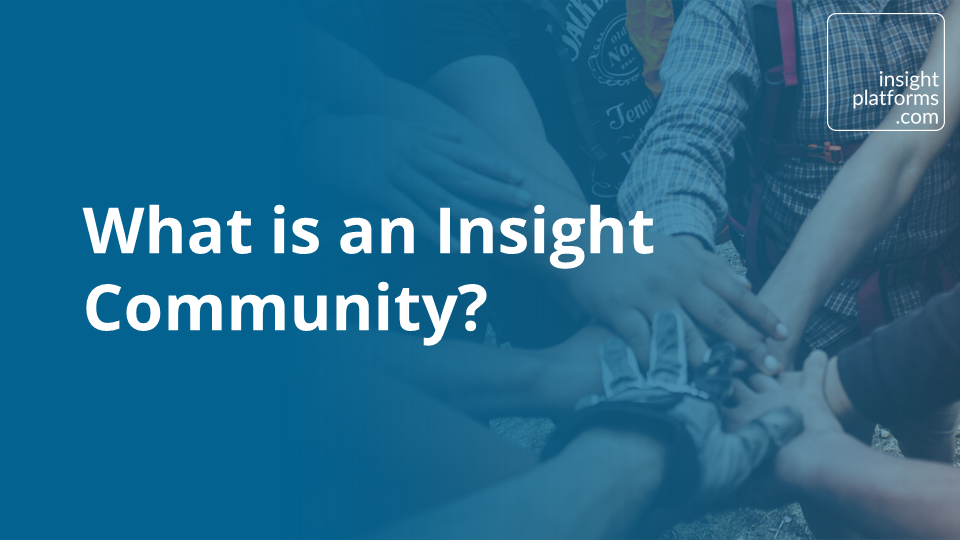
What is an Insight Community?
By Insight Platforms
- explainer
- Insight Communities
- Online Communities
- Short Term Communities
- Long Term Communities
An insight community is a way of conducting research with a group of people over a period time. This group can be very large (thousands of people), very small (less than a dozen), or anywhere in between.
Insight communities can last a few days or continue indefinitely. They can be closely controlled or they can very open and organic.
Confused?
That’s because ‘insight community’ is one of the most stretched and abused terms in research. They are variously called research communities, MROCs, fan panels, customer advisory groups, consulting boards, and a dozen other things.
Simply put, insight communities are generally collections of people who are willing to talk to you more than once. Agencies and platform providers like inventing their own language to add mystique and premium. Let’s unpick all this and try to define what we’re really talking about.
First, we’ll talk about the attributes of insight communities: what are the different factors that go into them?
Then, we’ll cover some applications for insight communities: what should you use insight communities for? And what shouldn’t they be used for?
Key Attributes of Insight Communities
1. Engagement
Insight communities depend on engagement. If your topic or brand doesn’t interest people, they won’t give you helpful feedback. This engagement can be authentic or manufactured.
- Authentic is “I really like Formula 1 and it makes me feel special to be part of the Formula 1 community.”
- Manufactured is “OK I’ll keep answering your surveys about toothpaste because you’re paying me.”
Generally, insight communities are more successful when members are authentically engaged with it.
2. Customers
More often than not, insight community members are existing users of a product, brand or service. You don’t want people who don’t use your thing to give you feedback about it.
This means you have to be careful with sample bias: hyper-engaged current customers (potentially your superfans) will have different expectations – and give different answers – to people who don’t buy from you and don’t care much about you.
That’s not necessarily a problem but it’s important to account for sample bias, just like with any research project.
3. Control
Insight communities are not Reddit groups – don’t expect them to be self-sustaining, self-generating fountains of organic insight.
Very few are a complete free-for-all. Some are a little open – they allow participants to start their own discussions and generate their own content, but most follow a more structured research plan, with topics, tasks, or questions decided by a research team or moderator.
4. Duration
Insight communities can be pretty short – even less than a week. For example, it could be one with food experts that lasts 2 weeks to co-create some new ice cream flavours. It could also be one with mobile phone subscribers running for years.
The thread that holds them together (if there really is one) is the idea of iterative insight – being able to build on knowledge, dig deeper into prior answers, or connect insights together over time. These features are much more a hallmark of insight communities than their duration.
5. Visibility
Insight communities are almost always private, invitation only and commercially confidential. The confidential bit doesn’t always work out, though. A few years ago, a well-known sports brand tested a risky (and very sweary) rough cut of a TV ad in its community. Despite reminding members of their obligation not to share, a copy of the video was posted to Facebook within an hour of the study going live.
It was a teenage brand fan – who then took a very short trip from excited insider to traumatised recipient of a takedown notice from the brand’s legal team.
There can be merit in the open format for crowdsourcing, co-creation, or product roadmap suggestions – all first cousins of insight communities. Think My Starbucks Idea or Lego Ideas. Forum-based community platforms are also often used for insight generation. UK mobile operator GiffGaff has no helpdesk or support staff; instead, its low-cost model is supported by member-to-member advice in their community.
6. Activities
Insight communities can help you do really creative research: engaged participants doing fun, immersive tasks to bring some fresh perspective. There are platforms to do digital scrapbooks, diaries, real-time chats, online whiteboards, video blogs, multi-stage discussions, and purchase journey tracking. The only inhibitor is imagination.
The risk in many long-term communities is that imagination dries up, or people move on – and the research defaults to quick polls, short surveys, and projects for validation/testing. They key is to anticipate this trap and avoid it by keeping a mix of different activity types and ensuring you engage members regularly.
7. Size
Insight communities can be big or small, just like they can be short or long. You can have insight communities that are small and short; small and long; or big and long. But they are almost never big and short.
That’s called a survey. There’s no point in recruiting a large number of people to something that will only last a week. There are more cost-effective ways to get your insight.
8. Incentives
Insight community members are engaged in ways that are authentic or manufactured. Even the authentically engaged sometimes need a little encouragement.
Money talks. If you only demand a few minutes of their time each month, you can get away with regular prize draws. But if you’re asking for more of people’s time, you have to pay them cold hard cash. For some communities, this is $5, $10, or $20 a month; for others, the payment is for specific projects. It can add up quite quickly, so bear that in mind with communities of thousands.
You can also reward people in more creative ways: expenses paid trips to head office, a year’s supply of gummi bears, etc. Be careful offering your own product as incentives as that practice is on the naughty list for the UK’s Market Research Society.
Applications for Insight Communities
Here are 5 of the main ways insight communities tend to be used.
1. Exploration
Insight communities are great for getting into the lives of your users and customers. Over time, you can build a level of trust and enthusiasm with community participants that is often lacking in ad hoc projects.
People are willing to share more about their personal context, behaviour and usage. This can help round out your understanding of how products are used in situ, map how the purchase journey happens, and identify the invisible influences that impact on choice.
2. Innovation and New Product Development
For ideation and co-creation, groups of engaged, knowledgeable users are a fantastic resource. They can help you generate, develop, and refine fresh ideas. They can also help you identify white space, find opportunities for brand extensions or pick up on emergent competitors that weren’t on your radar.
You can also use larger communities to test concepts and validate ideas quantitatively – but again, be careful with your sample bias. Remember who your members are, and don’t assume you have a good proxy for the total market.
3. Communications Development and Testing
As with new product ideas, communities can be great for developing new concepts for above-the-line campaigns and promotions.
They can also help you build on and refine existing ideas.
But again – be very careful testing ads quantitatively.
4. User & Product Research
Insight communities can also be helpful for design and usability testing of digital products. If your community is integrated with your CRM platform, you can even use event triggers or usage data from websites apps and e-commerce platforms to sample specific target groups.
Having an engaged group of people is useful when you want them to do some more involved research: screen-record their user journey, follow a set of steps online, or even make a purchase.
5. Customer Experience Development
Understanding and enhancing the customer experience often involves piecing together disparate behaviours, channels, and data sources. This is where the continuous nature of insight communities helps: longer term research projects can get rich feedback from members as they go through a wide range of touch-points (in store, call centre, online etc).
This helps build up much richer, composite pictures across whole experience and can add depth the metrics-driven approach of Voice-of-Customer and NPS tracking data.
A final note
So what is an insight community?
Its typical attributes: engaged groups of customers or users; taking part repeatedly over a period of time; responding to a wide variety of tasks set by researchers and moderators; doing so in a private, invite-only environment; and being rewarded with prizes, cash or some other incentive.
What can you do with an insight community?
All types of creative, iterative research projects: understanding users’ lives; developing new products; co-creating new ads; testing digital mockups; building better experiences. Just don’t use a community as a proxy for a representative sample.

